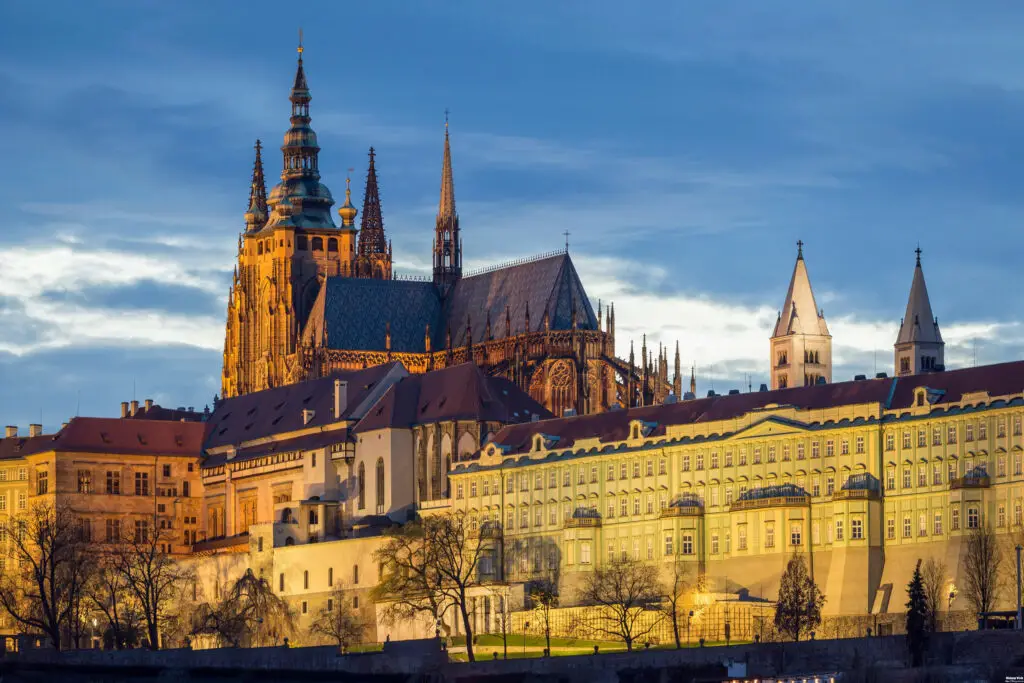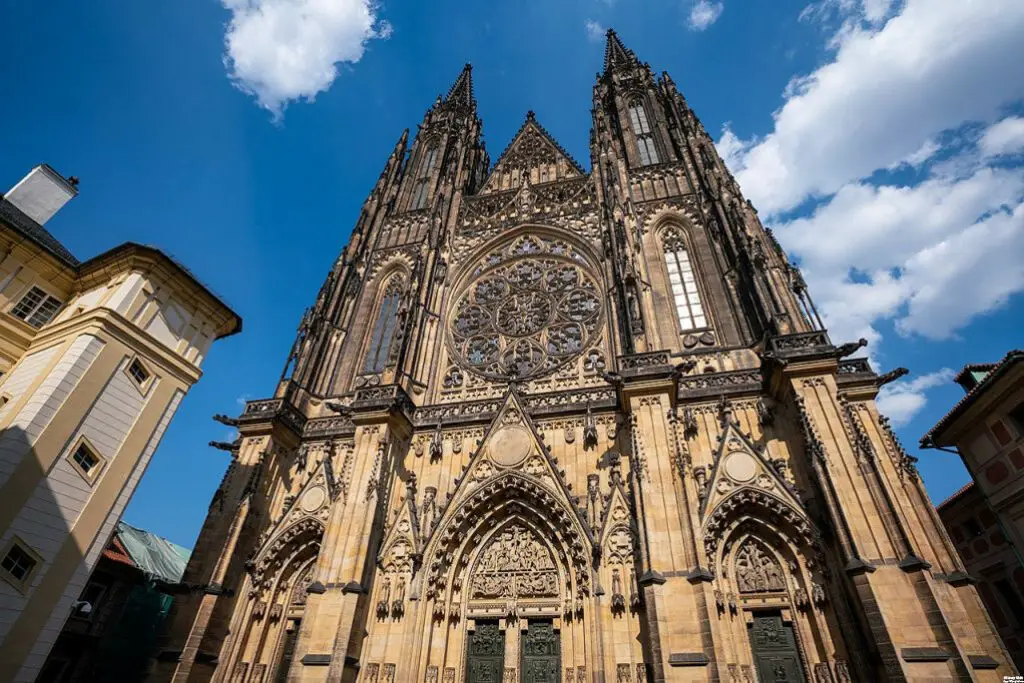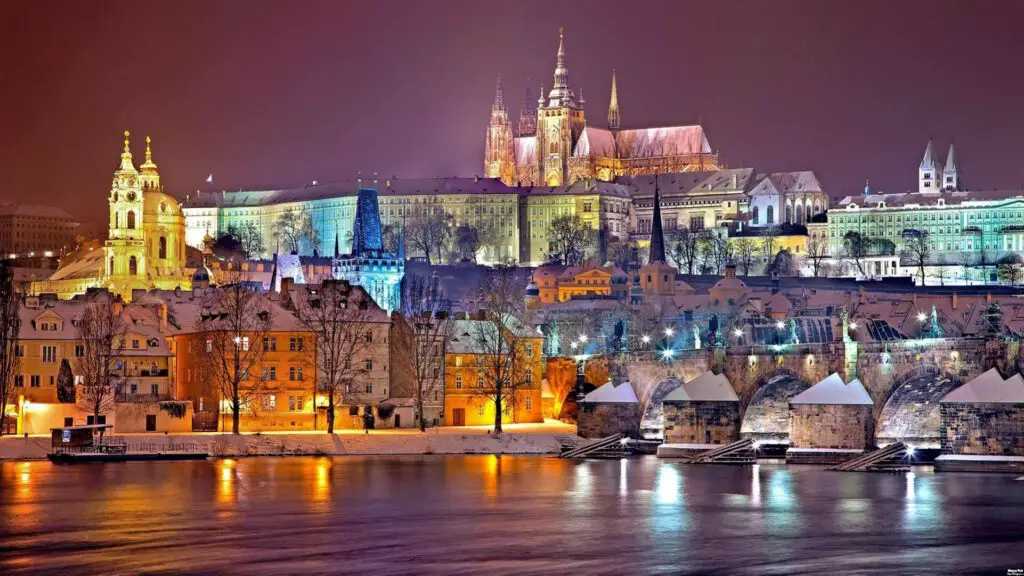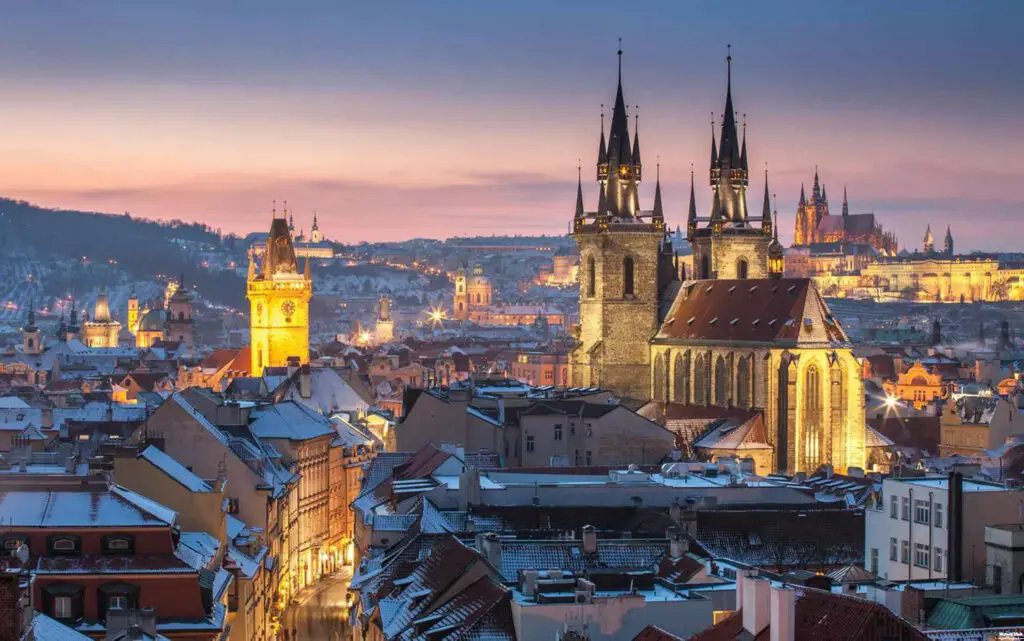Prague Castle: A Symbol of Power and Cultural Heritage

Introduction
Prague Castle, perched majestically on a hill overlooking the Vltava River, is not only the largest ancient castle in the world but also one of the most significant historical and cultural landmarks in the Czech Republic. As a symbol of the nation’s rich history and power, it has been the seat of Czech kings, emperors, and presidents for over a thousand years. This vast complex, with its blend of architectural styles and historical significance, continues to captivate visitors from around the globe.
The castle’s origins date back to the 9th century, and over the centuries, it has undergone numerous expansions and renovations, each adding to its architectural splendor and historical depth. Today, Prague Castle is a UNESCO World Heritage site, attracting millions of visitors who come to marvel at its Gothic cathedrals, Renaissance palaces, and Baroque gardens. The castle not only reflects the evolution of architectural styles but also serves as a testament to the Czech Republic’s enduring cultural and political legacy.
In this article, we will explore the strategic location and early history of Prague Castle, its architectural evolution, its role as a political and cultural hub, the preservation efforts that have maintained its grandeur, and provide practical information for those wishing to tour this magnificent complex. Through this exploration, we will uncover the layers of history and culture that make Prague Castle a unique and enduring symbol of Czech heritage.
The Strategic Location and Early History

Prague Castle’s strategic location on a hilltop overlooking the Vltava River has played a crucial role in its historical significance. This elevated position provided a natural defense against invaders, making it an ideal site for a fortress. The castle’s location also offered control over the trade routes that passed through the region, further enhancing its strategic importance. As a result, Prague Castle became a center of power and influence in Central Europe.
The early history of Prague Castle dates back to the 9th century when it was founded by Prince Bořivoj of the Přemyslid dynasty. The original structure was a wooden fortification that served as a royal residence and a religious center. Over time, the wooden fort was replaced by stone buildings, and the castle began to take on the appearance of a medieval stronghold. The construction of St. Vitus Cathedral, initiated by Prince Wenceslas I in the 10th century, marked a significant development in the castle’s history, establishing it as a spiritual and cultural center.
Throughout the medieval period, Prague Castle continued to grow and evolve. Under the reign of Charles IV in the 14th century, the castle underwent extensive renovations, including the expansion of St. Vitus Cathedral and the construction of new fortifications. Charles IV’s vision was to transform Prague into a grand imperial city, and the castle played a central role in this transformation. The Gothic elements introduced during this period remain some of the most striking features of the castle complex today.
Architectural Evolution

Prague Castle is a remarkable testament to the evolution of architectural styles over the centuries. The castle complex encompasses a variety of buildings, each representing different periods and styles, from Romanesque to Gothic, Renaissance, Baroque, and modern influences. This architectural diversity is a reflection of the castle’s long and storied history.
The Gothic period is perhaps best represented by St. Vitus Cathedral, a masterpiece of Gothic architecture. Construction of the cathedral began in the 14th century under the direction of Matthias of Arras and later Peter Parler. The cathedral’s soaring spires, intricate stone carvings, and stunning stained glass windows are hallmarks of Gothic design. St. Vitus Cathedral not only serves as a place of worship but also as the final resting place of many Bohemian kings and Holy Roman Emperors.
The Renaissance influence on Prague Castle is evident in the addition of elegant palaces and gardens. During the reign of Emperor Ferdinand I in the 16th century, the castle underwent significant Renaissance renovations. The Old Royal Palace, with its grand Vladislav Hall, is a prime example of this period’s architecture. The hall, known for its impressive ribbed vaulting and vast open space, was used for banquets, coronations, and even jousting tournaments.
The Baroque period brought further transformation to the castle complex. The addition of the beautiful Baroque gardens, fountains, and the construction of new buildings like the Summer Palace of Queen Anne, also known as the Belvedere, added to the castle’s grandeur. These Baroque elements, with their ornate designs and emphasis on beauty and symmetry, contrast beautifully with the earlier Gothic and Renaissance structures, creating a harmonious blend of architectural styles.
Political and Cultural Hub

Prague Castle has long been the political heart of the Czech Republic, serving as the seat of power for kings, emperors, and presidents. Its role as a political hub dates back to its early history when it was the residence of Bohemian princes and later the kings of Bohemia. Throughout the centuries, the castle has been the site of numerous historical events, political decisions, and state ceremonies.
The castle’s influence extends beyond politics to culture and the arts. It has been a center for cultural events, artistic endeavors, and scholarly activities for centuries. The establishment of St. Vitus Cathedral as a religious and cultural center in the 10th century set the stage for the castle’s long association with cultural and intellectual pursuits. The cathedral’s treasury holds an extensive collection of religious artifacts, manuscripts, and artworks, reflecting the castle’s cultural significance.
In modern times, Prague Castle continues to serve as a cultural hub. It hosts numerous events, including concerts, exhibitions, and festivals, attracting artists and visitors from around the world. The castle’s courtyards and gardens provide a picturesque setting for cultural activities, while its museums and galleries offer insights into Czech history and heritage. The annual Prague Castle Wine Festival and the Christmas markets held within the castle grounds are just a few examples of the vibrant cultural life that the castle supports.
Preservation and Modern Use
Preserving the historical integrity of Prague Castle has been a complex and ongoing challenge. Over the centuries, the castle has faced threats from wars, fires, and natural disasters. However, extensive preservation efforts have ensured that this architectural and historical gem remains intact for future generations to appreciate. Major restoration projects have been undertaken to repair damage, restore original features, and maintain the structural stability of the castle.
One of the most significant restoration efforts occurred in the 20th century, following the establishment of Czechoslovakia. This period saw extensive work to restore the castle’s various buildings and adapt them for modern use. The restoration was guided by meticulous research and a commitment to preserving the castle’s historical authenticity. Modern adaptations have included the installation of amenities and facilities to accommodate the needs of contemporary visitors while maintaining the castle’s historical character.
Today, Prague Castle serves multiple purposes, blending its historical legacy with modern functionality. It remains the official residence of the President of the Czech Republic and houses various government offices. Additionally, the castle is a major tourist attraction, welcoming millions of visitors each year. The blend of historical preservation and modern use ensures that Prague Castle continues to be a living monument, reflecting both the past and present of the Czech Republic.
Touring Prague Castle

Visiting Prague Castle is an enriching experience that offers a glimpse into the Czech Republic’s rich history and architectural heritage. The castle complex is open to the public, and visitors can explore its many attractions, including palaces, churches, gardens, and museums. Guided tours are available in multiple languages, providing valuable insights into the history and significance of the various sites within the castle complex.
One of the highlights of any visit to Prague Castle is St. Vitus Cathedral. Visitors can admire the cathedral’s stunning Gothic architecture, explore its chapels, and view the tombs of Bohemian kings and Holy Roman Emperors. The cathedral’s Great South Tower offers panoramic views of Prague, making it a popular attraction for visitors. Another must-see is the Old Royal Palace, with its impressive Vladislav Hall and historical exhibits.
The Golden Lane, a charming street within the castle complex, is another popular attraction. Lined with colorful, small houses that once housed castle guards and craftsmen, the Golden Lane offers a glimpse into the everyday lives of the castle’s inhabitants. Today, the houses have been converted into shops and museums, showcasing medieval armor, weaponry, and crafts. Visitors can also explore the castle’s gardens, which provide a peaceful retreat and stunning views of the city.
Conclusion

Prague Castle stands as a remarkable testament to the Czech Republic’s rich historical, cultural, and architectural heritage. Its strategic location, architectural evolution, and role as a political and cultural hub make it a unique and captivating destination. The castle’s resilience through centuries of change and its successful preservation efforts highlight the importance of maintaining and celebrating historical landmarks.
As we have explored in this article, Prague Castle’s strategic location, early history, architectural evolution, political significance, and cultural contributions all contribute to its enduring legacy. The ongoing preservation and modern adaptations ensure that this UNESCO World Heritage site remains a vibrant and accessible part of the Czech Republic’s cultural landscape.
For those fortunate enough to visit, Prague Castle offers a profound and immersive experience that allows them to connect with the rich history and cultural traditions of the Czech Republic. It is a place where history and art converge, creating a timeless monument that continues to captivate the hearts and minds of all who encounter it. Prague Castle remains a beacon of cultural heritage, a symbol of the Czech nation’s enduring spirit, and a testament to the power of history and architecture.


